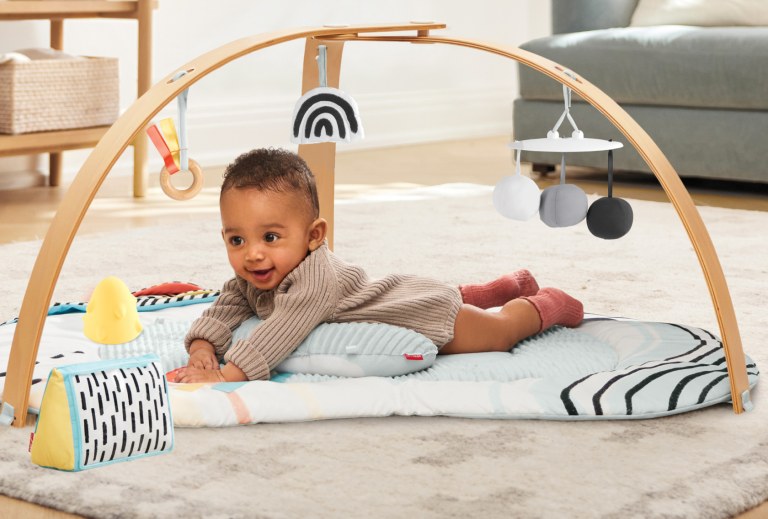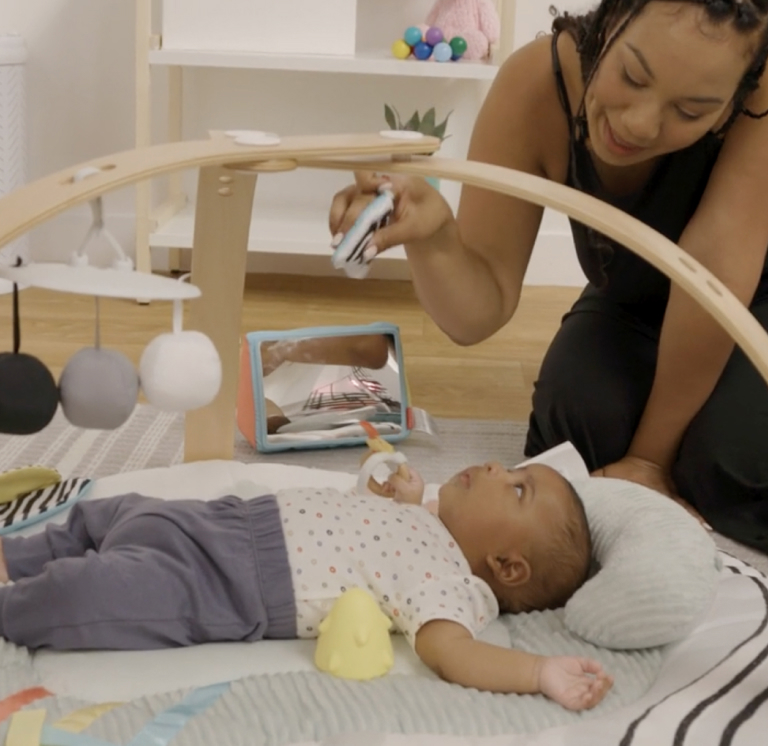
Playful Learning: Montessori-Inspired Gym Activities for Babies 0-6 Months
Video: Babylist Scout Kayla tests the Skip Hop Discoverosity Play Gym

By Alyssa Lofgren
Play can be a really important part of baby’s early development (even starting at birth!), but babies aren’t exactly super active the first few months of their lives. In the video above, we look at different ways you can encourage your baby’s development through play that is just right for their age, using the Skip Hop Discoverosity Montessori-Inspired Play Gym. This modern-looking gym was designed in collaboration with experts in Montessori education to help your baby learn through play.
What is Montessori-inspired Play?
Montessori learning usually involves a few different core principles, with an emphasis on child-led learning and independence through play. For example, one Montessori philosophy is that a simple playspace promotes focus and independence. Another philosophy is to present just the right amount of challenge for your baby, making things not so easy that your child gets bored, and not so complicated that they get frustrated. Here are a few ways you can implement these principles with baby starting at birth, using the Skip Hop Discoverosity Montessori-Inspired Play Gym.
1. Tummy Time
Tummy time helps babies strengthen the muscles in their necks, backs, trunks, and shoulders. It can also help with preventing a flat spot on their head, called plagiocephaly. Babies don’t always love tummy time, but you can make it more comfortable by propping baby up on a support like the one that comes with the Skip Hop Discoverosity Gym.
The fabric in this gym is Oeko-Tex certified, so it’s made from sustainable sources and is free from up to 350 chemicals harmful to baby. Mirrors (like this one!) also help encourage visual awareness while in tummy time.

2. Visual Development
Most babies begin to recognize themselves around 18-24 months, but until that time, you can support baby’s visual development with contrasting colors. You know how you often see black and white baby toys, like the stripes on the Discoverosity play mat? In the early days of baby’s life, contrasting colors are more likely to attract their attention. To help them focus on objects, look for toys that have high contrast in colors and patterns; black and white is best for newborns.

3. Grasping
Around one month, baby is grasping with their balled-up, tight little fists. Encourage that motion during tummy time, by helping them explore the different textures of their play mat. When baby is on their tummy, they can reach for things like the adorable rainbow rattle on the Discoverosity play gym (it’s two-sided to keep baby’s interest; one side is black and white and one side is in color). Or when they’re on their back, they can practice grasping by reaching for the hanging toys.

4. Sounds and Voice
Around two months, baby is probably cooing and gurgling. Your little one inherently loves the sound of your voice, so you can coo and gurgle back, sing lullabies or your favorite songs, or read them your favorite bedtime stories. They will also be reacting to sounds, so fun surprises like the crinkling fabric leaves on this mat help spark that curiosity.
5. Peek-A-Boo
Play peek-a-boo with your baby to get them laughing, smiling, and gearing up for object permanence—which is when baby starts to realize that even if things disappear from their view (like a favorite toy, or in this case, you), that those things still exist.
6. Tracking Objects
Baby can start tracking objects visually around three months. To encourage this skill, you can do something as simple as gently blowing or tapping a mobile to make it move (that’s why most play gyms feature hanging toys). When you see baby’s eyes following an object, that’s actually big-time processing happening with their eyesight and brain.
The dark-to-light color gradients on this play gym help little eyes process shades of color. And pro tip: the Discoverosity play gym has removable toys so baby can continue playing with their favorite toys and tracking objects beyond their gym, like in their stroller when on a walk.
7. Fine and Gross Motor Skills
Another big thing that happens between the four through seven month range is the development of fine and gross motor skills—which can look like reaching, grabbing, and holding on. The toys on this play gym are designed to help encourage that movement, like the wooden ring that little hands can easily grasp or the texture of this ball, which encourages a pinching grip.

8. Guided Movement
Around six months, you may start noticing baby making some big leaps in development and how they “play” or react to your prompting. Remember what we said about making things not so easy that your child gets bored, and not so complicated that they get frustrated? Putting something just out of reach is a great way to gently challenge baby during this time.
If you sometimes stare at your baby and wonder “What do we DO all day?” development-based play like this could be a good start. The Skip Hop Discoverosity Montessori Play Gym even comes with six parent cards (see them at the 4:06 mark in our video) to guide you through milestone-driven play and give you more insight into Montessori methods.
So if you’re looking for toys that help enhance developmental play AND look cute in your living room, this is a solid choice to help you and baby discover, learn, and grow together.
This article is sponsored by Skip Hop. Babylist’s free site, apps and emails are made possible by our sponsors. We limit our sponsored content to relevant partners that offer products and services we believe in and use ourselves.
